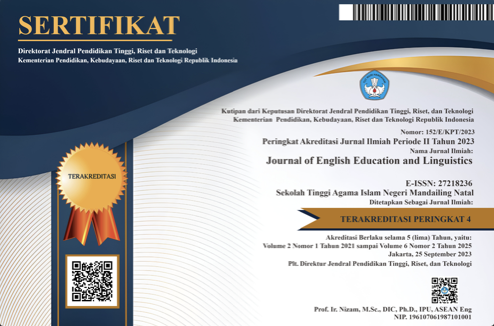Politeness Used by Islamic Education Department Administration Staff of State Islamic University North Sumatra. Postgraduate School of the State University of Medan
DOI:
https://doi.org/10.56874/jeel.v1i1.139Keywords:
Politeness Strategies; Islamic Education; Administration StaffAbstract
The objectives of this study is to find out what and how the using of politeness strategies used by Islamic Education Department Administration Staff and why they use it when interact with the students by using Brown and Levinson theory. This research is qualitative study. The data is gathered from administration staff who work in Islamic Education Department of State Islamic University North Sumatra. To get the data the researcher used sound recorder to find out the use of politeness strategies. From the analysis, the researcher found that there are four politeness strategies used by administration staff when they interact to the students. They are greeting, question, command, and request. The most of strategies used in the field are bald on record rather than positive and negative politeness strategy. They used these strategies to save the time, because there are so many students have to be served. The other reason is diversity age and avoiding the ambiguity. The staff sometimes uses positive and negative politeness strategies. They used positive politeness especially for recognized students to make closeness and friendly when they ask them to do something and they used negative politeness strategies to save face student awareness when the staff tried to judge students by doing mistake. The implication of this study is to increase the using of positive politeness strategies when administration staff talk to the students. This is because the positive politeness strategies can minimize Face Threatening Acts to endeavor a harmony in social interaction.
References
Aridah, Politeness Phenomena as a Source of Pragmatic Failure in English as a Second Language.
Brown, P. and Levinson, C. S. (1987). Politeness: Some Universals in Language Usage. United Kingdom: Cambridge University Press.
Bogdan, R & Biklen, S. (1982). Qualitative Research for Education (2nd ed). Boston: Allan and Bacon.
Collins, R. (1981). Sociology Since Midcentury (Essays in Theory Cumulation). New York: Academic Press.
Cutting, J. (2008). Pragmatics and Discourse: A Resource Book for Students. London: Routledge. Communication: Concepts and Processes (Edited) (Englewood Cliffs, New Jersey: Prentice-Hall, 1971, Revised and Enlarged Edition, 1976, Third Edition, 1981)
Denzin, N.K., & Lincoln, Y.S. (1994) Handbook of Qualitative Research. Thousand Oaks: Sage Publication
Douglas, K. M., Sutton, R. M., & McGarty, C. (2008). Strategic language use in interpersonal and intergroup communication. In Y. Kashima, K. Fiedler & P. Freytag (Eds.), Stereotype dynamics: language-based approaches to the formation, maintenance, and transformation of stereotypes New York: Taylor and Francis Group.
Drew, P. & Heritage, J. (1992) Analyzing Talk at Work: An Introduction. In: Drew, P. & Heritage, J. (Eds.), Talk at Work: Interaction in Institutional Settings. Cambridge University Press, Cambridge
Goodwin, M.H. (1980) : Processes of mutual monitoring implicated in the production of description sequences. Sociological Inquiry
Goffman, E. 1967. Interactional Ritual. Chicago: Aldine Publishing.
Heritage, J. & Atkinson, J. M. (1984) Introduction. In: Atkinson, J. M. & Heritage, J. (Eds.),
Structures of Social Action. Cambridge University Press, Cambridge.
John A. D. and Anita L. V. in John O. Greene and Brant R. Burleson. (2003). Handbook of
Communication and Social Interaction Skills. London: Lawrence Erlbaum Associates. Lakoff, R. (1990) Talking Power: The Politics of Language. New York: Basic Books.
Lakoff, T. R. and Ide S. (2005) Broadening the Horizon of Linguistic Politeness. Philadelphia:
John Benjamins Publishing Company.
Lincoln, Y.S., & Cuba, E.G (1985) Naturalistic Inquiry. California: Sage Publication.
Leech. N. G. (1983) Principle of Pragmatic. New York. Longman.
Markus, M. (2011) Politeness in Interaction: an Analysis of Politeness Strategies in Online
Learning and Teaching.
Miles, M.B., & Huberman, A.M. (1984). Qualitative Data Analysis. Beverly Hills, CA: Sage Moffatt, A. (2012). Indonesian Culture Profile. London; Diversicare Publisher.
Moleong, L. J. (2010) Metodologi Penelitian Kualitatif. Bandung: Remaja Rosda Karya
Murni, S. M. (2013) Kesantunan Linguistik. Medan: Unimed Press.
Nahla N. B. (2012) Gender and Politeness in a Foreign Language Academic Context.
International Journal of English Linguistic. Beirut: Lebanese American University.
Nunan D. (1992) Research Methods in Language Learning. New York: Cambridge University
Press.
Rebrová, S. and Ondrejová, Zuzana. Indonesian Business Etiquette, Language and Culture. Reiter, R. M. (2000) Linguistic Politeness in Britain and Uruguay: a Contrastive Study of
Requests and Apologies. Philadelphia: John Benjamins Publishing Company.
Rezeky A. A. (2014). Politeness Strategies Used by Customer Service Staff at Mandiri Bank Sacks, H., Schegloff, E. A., & Jefferson, G. (1974) A Simplest Systematics for the Organization
of Turn-Taking for Conversation.
Schegloff, E. A. (2006) Sequence Organization in Interaction. Cambridge University Press,
Cambridge.
Schegloff, E. A. & Sacks, H. (1973) Opening Up Closings.
Seidel, J. V. (1998). Qualitative Data Analysis. Qualis Research, Qualis@qualisresearch.com Silvia R. and Zuzana O. Indonesian Business Etiquette, Language and Culture.
Tuner, J.L., Miller, M. and Kernan, C.M (2002) Discipline Cultures and Graduate Education. Wardhaugh. R. (2010) An Introduction to Sociolinguistic. (Sixth Edition). United Kingdom. A
John Wiley & Sons.
Yule, G.. (1996) Pragmatics. New York: Oxford University Press. www.wikipedia.com
Downloads
Published
Issue
Section
License
All articles published in the Journal of English Education and Linguistics are licensed under a Creative Commons Attribution-ShareAlike 4.0 International (CC BY-SA) license. This means anyone is free to copy, transform, or redistribute articles for any lawful purpose in any medium, provided they give appropriate attribution to the original author(s) and Journal of English Education and Linguistics, link to the license, indicate if changes were made, and redistribute any derivative work under the same license.
Copyright on articles is retained by the respective author(s) without restrictions. A non-exclusive license is granted to the Journal of English Education and Linguistics to publish the article and identify itself as its original publisher, along with the commercial right to include the article in a hardcopy issue for sale to libraries and individuals.
Although the conditions of the Creative Commons Attribution-ShareAlike 4.0 International (CC BY-SA) license do not apply to authors (as the copyright holder of your article, you have no restrictions on your rights), by submitting to the Journal of English Education and Linguistics, authors recognize the rights of readers and must grant any third party the right to use their articles to the extent provided by the license.

This work is licensed under a Creative Commons Attribution-ShareAlike 4.0 International License.








